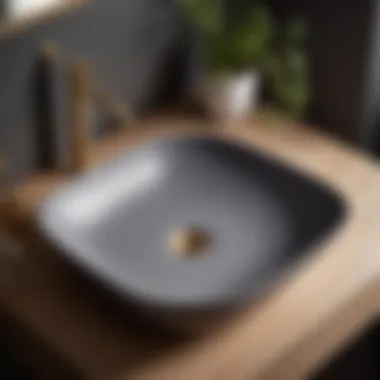Materials:
- Porcelain sink paint (1 quart)
- Primer for porcelain surfaces (1 can)
- Paintbrushes (sizes: 1 inch and 2 inches)
- Painter's tape
- Sandpaper (fine grit)
- Clean cloths
- Painter's mask
- Safety goggles
Step-by-Step Instructions:
-
Preparation: Start by cleaning the sink thoroughly with a gentle cleanser to remove any dirt or grime. Use a clean cloth to dry the sink completely.
-
Sand Surface: Lightly sand the entire surface of the porcelain sink using fine-grit sandpaper. This step helps the paint adhere better to the smooth surface.
-
Priming: Apply a coat of primer specifically designed for porcelain surfaces. Use a paintbrush to ensure even coverage. Let the primer dry according to the manufacturer's instructions.
-
Painting: Stir the porcelain sink paint thoroughly before application. Use a 1-inch brush for corners and edges, and a 2-inch brush for larger areas. Apply the paint in thin, even coats, allowing each coat to dry completely before adding the next.
-
Drying Time: Allow the final coat of paint to dry for at least 24 hours before using the sink. This ensures that the paint sets and cures properly for long-lasting results.
-
Finish: Once the paint is fully dry, carefully remove any painter's tape used to protect surrounding areas. Clean up any stray paint marks with a damp cloth.
Technical Aspects:
- Time: Allow 2-3 days for the entire painting process, including drying times.
- Tools: Ensure proper ventilation when working with paints and wear a painter's mask and safety goggles for protection.
- Techniques: Apply paint in thin, smooth strokes to achieve a professional finish. Avoid thick layers that can lead to drips and uneven coverage.
Troubleshooting Tips:


- If the paint starts to chip or peel, gently sand the affected area and repaint for better adhesion.
- For stubborn stains, use a mild abrasive cleaner to maintain the painted surface without damaging the finish.
Introduction


In the realm of home improvement, the porcelain sink stands out as a fixture that blends functionality with aesthetics, adding a touch of sophistication to any kitchen or bathroom. The choice of paint for porcelain sinks is paramount in the renovation process, as it not only enhances the visual appeal but also contributes to the sink's longevity and resilience. Understanding which paint options work best for porcelain surfaces is crucial for achieving a durable and visually pleasing outcome. This article delves into the intricacies of selecting the best paint for porcelain sinks, shedding light on the various factors to consider and the top choices available in the market.
Porcelain sinks, known for their elegant finish and durability, require specialized care and attention when it comes to painting. Whether aiming to refresh the sink's appearance or repair minor imperfections, choosing the right paint can make a significant difference in the overall outcome of the renovation project. By exploring the unique qualities of different types of paint suitable for porcelain sinks, individuals can navigate through the myriad of options with confidence and informed decision-making. This comprehensive guide is designed to provide insights into the nuances of painting porcelain sinks, empowering homeowners with the knowledge needed to embark on a successful renovation journey.
Understanding Porcelain Sinks


Characteristics of Porcelain Sinks
Porcelain sinks are crafted from a combination of clay and other minerals, then fired at high temperatures to create a smooth, glass-like surface. This process results in a non-porous finish that is resistant to stains, scratches, and corrosion. Additionally, porcelain sinks come in a variety of shapes, sizes, and styles to complement any design aesthetic, from traditional to modern.
Maintaining porcelain sinks is relatively straightforward, requiring gentle cleaning with non-abrasive cleaners to preserve their pristine appearance. However, their glossy finish can make paint adhesion challenging, highlighting the importance of using the appropriate paint and preparation techniques for a long-lasting finish.
Challenges in Painting Porcelain Sinks
One of the primary challenges in painting porcelain sinks lies in ensuring paint adhesion and durability on the smooth, non-porous surface. Improper preparation or using the wrong type of paint can lead to peeling, chipping, or discoloration over time, compromising the sink's appearance.
Another challenge is selecting a paint that can withstand frequent exposure to water and chemicals, common in sink usage. The paint chosen must exhibit high resistance to moisture, stains, and cleaning agents to maintain its integrity and color vibrancy despite regular contact with these elements.
To overcome these challenges, thorough surface preparation, including cleaning, sanding, and priming, is vital to promote paint adhesion. Additionally, opting for specialized paints designed for porcelain surfaces can help enhance durability and ensure a professional-quality finish that lasts.
Types of Paint for Porcelain Sink
When considering the best paint for a porcelain sink, it is crucial to understand the different types available in the market. Each type of paint offers unique properties that impact the durability, aesthetics, and overall performance of the sink's finish. By exploring the various options, individuals can make informed decisions that suit their specific needs and preferences.
Epoxy Paint
Epoxy paint is a popular choice for painting porcelain sinks due to its exceptional durability and resistance to water and chemicals. This type of paint forms a strong bond with the sink's surface, creating a long-lasting finish that can withstand everyday use. Additionally, epoxy paint is available in a wide range of colors, allowing homeowners to customize the look of their sink according to their taste.
Acrylic Paint
Acrylic paint is another common option for porcelain sinks, known for its quick drying time and ease of application. This type of paint is water-based, making it environmentally friendly and safe for indoor use. However, acrylic paint may not offer the same level of durability as epoxy paint, making it more suitable for sinks with lower traffic or lighter use.
Alkyd Paint
Alkyd paint is a solvent-based paint that provides a durable and smooth finish on porcelain sinks. This type of paint offers excellent adhesion to various surfaces, including porcelain, and is resistant to moisture and stains. While alkyd paint takes longer to dry compared to acrylic paint, it delivers a hard finish that is resistant to chipping and peeling.
Two-Part Epoxy Paint
Two-part epoxy paint consists of a resin and a hardener that need to be mixed before application. This type of paint offers superior durability and chemical resistance, making it an ideal choice for high-traffic sinks subjected to frequent use. While the application process may be more complex than with single-component paints, the end result is a resilient finish that can last for years to come.
Factors to Consider When Choosing Paint
When it comes to selecting the best paint for your porcelain sink, several crucial factors need to be taken into consideration to ensure a successful renovation or revamping project. Understanding these factors will not only enhance the aesthetics of your sink but also contribute to its longevity and functionality.
Durability
Durability is a key factor to consider when choosing paint for your porcelain sink. The paint needs to withstand constant exposure to water, cleaning agents, and daily wear and tear. Opting for a high-quality, durable paint will ensure that your sink maintains its fresh appearance for an extended period, reducing the need for frequent touch-ups or repaints.
Resistance to Water and Chemicals
The resistance of the paint to water and chemicals is paramount for a porcelain sink, as it regularly comes into contact with moisture and cleaning solutions. Selecting a paint that is specifically designed to resist water and chemicals will prevent the paint from peeling, fading, or discoloring over time. This resistance not only maintains the beauty of your sink but also contributes to its overall hygiene and cleanliness.
Aesthetics and Color Options
Aesthetics play a significant role in the overall look and feel of your porcelain sink. Choosing a paint that complements your existing decor or allows for a new color scheme can transform the visual appeal of your sink. Additionally, considering color options that are not only pleasing to the eye but also resistant to fading or yellowing will ensure a long-lasting finish that maintains its vibrancy.
Application Method and Ease of Use
The application method and ease of use of the paint are essential aspects to consider, especially for those undertaking a DIY project. Opting for a paint that is easy to apply, whether with a brush, roller, or sprayer, can make the painting process smoother and more efficient. Additionally, paints that come with clear instructions and minimal preparation requirements can simplify the task, resulting in a professional-looking finish.
These factors should guide your decision-making process when choosing the best paint for your porcelain sink, ensuring a successful and satisfying outcome for your home improvement project.
Conclusion
In the realm of porcelain sink renovation, the conclusion serves as the culminating factor that ties together the entirety of this exploration into the best paint options. The importance of the conclusion cannot be overstated, as it consolidates the detailed insights gleaned from each preceding section, offering a definitive stance on how to approach painting porcelain sinks effectively.
One of the key elements highlighted in this article is the significance of choosing the right type of paint for porcelain sinks. By delving into the characteristics of various paint options such as epoxy paint, acrylic paint, alkyd paint, and two-part epoxy paint, individuals can grasp the nuances that differentiate each type and align them with their specific sink renovation requirements. Through understanding the attributes of each paint type, individuals can make informed decisions regarding durability, water and chemical resistance, aesthetics, and ease of application.
Furthermore, the benefits accrued from selecting the best paint for a porcelain sink are multifold. The chosen paint should not only enhance the visual appeal of the sink but also ensure long-lasting durability and resistance to daily wear and tear. Additionally, the aesthetic aspect of the paint plays a crucial role in elevating the overall ambiance of the kitchen or bathroom, where the sink serves as a focal point of utility and design.
Moreover, the considerations outlined throughout this article underscore the importance of meticulous planning and evaluation when embarking on a porcelain sink painting project. Factors such as durability, resistance to water and chemicals, color options, and application method play vital roles in determining the overall success of the endeavor. By carefully weighing these aspects and aligning them with personal preferences and practical needs, individuals can transform their porcelain sink into a functional and aesthetically pleasing element within their living space.





